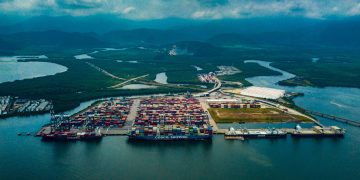The National Transportation Safety Board (NTSB) has published an investigation report into an incident where a fire erupted in the engine room of a cargo vessel during bunkering operations, claiming two lives.
The incident
On January 8, 2024, about 0331 local time, a fire broke out in the engine room aboard the cargo vessel Stride during bunkering operations while it was docked at the Barbours Cut Marine Terminal in LaPorte, Texas. Crewmembers shut down all ventilation to the engine room, and the fire self-extinguished. Shoreside firefighters and the ship’s emergency teams removed three crewmembers from the engine control room who were unable to escape the fire; two died on scene, and one was seriously injured. No pollution was reported. The vessel was declared a constructive total loss, valued at $12 million.
Analysis
On January 8, 2024, about 0330, while the cargo vessel Stride was docked in LaPorte, Texas, and conducting bunkering operations, a fire broke out in the engine room. The fire self-extinguished after crewmembers shut down all ventilation to the engine room from outside air by closing supply and exhaust ventilation dampers. Two crewmembers died as a result of the fire; one crewmember was seriously injured. The fire broke out in the engine room of the Stride about 25 minutes after the crew of the bunker barge began pumping diesel oil from the barge to the Stride. The chief engineer aboard the Stride had ordered 80 mt of diesel oil, which was to be loaded into the port and starboard DBDO tanks.
According to the bunkering survey report completed before bunkering operations began, the port DBDO tank had room for about 60 mt of diesel oil, and the starboard DBDO tank had room for about 37.2 mt until they were completely full. Using both DBDO tanks, there was room for about 97.2 mt of diesel oil. Therefore, there was sufficient capacity in the Stride’s port and starboard DBDO tanks to receive the 80 mt of diesel oil that had been ordered. Six weeks before the fire, a replacement valve was ordered for the port DBDO tank.
The vessel’s fuel oil system drawing clearly showed an angle stop valve for the port DBDO tank. This valve would have allowed fuel to flow through it in both directions when open. However, after the fire, investigators discovered that although the replacement valve that was ordered and installed looked similar from the outside and was of the correct dimensions, it was not the same type of valve specified by the vessel’s fuel oil system drawing; instead, an angle stop check valve, which allows flow in only one direction, even when open, was ordered. Therefore, even when the crew fully opened the valve, as installed in the Stride’s fuel oil system, the check valve feature would only allow flow out of the tank.

Moreover, the vessel had not bunkered diesel oil into the port DBDO tank since the valve replacement, and therefore the crew had no prior indication that the wrong valve type was ordered and installed. Unaware that diesel oil would not be able to flow into the port DBDO tank, engineering crewmembers on the Stride had opened the fill valves for both the port and starboard DBDO tanks to receive the diesel oil.
However, none of the estimated 52 mt of diesel oil that was transferred from the barge went into the port DBDO tank; instead, it went solely into the starboard DBDO tank, which only had capacity for about 37.2 mt until it was completely full. Additionally, all the diesel oil pumped from the barge was received into the starboard DBDO tank at a faster rate than expected, since only one tank was being filled.
The company required four engineering crewmembers and two engine ratings to be on duty during bunkering operations. However, at the time of the fire, only three engineering crewmembers (two engineering officers and one engine rating) were involved. The fitter was positioned at the bunkering station on the A deck, and the chief engineer and third engineer were the only other engineering crewmembers conducting the operation in the engine control room when the wiper reported seeing diesel oil in the engine room. Prudent marine practice during bunkering would be to fill slowly at first, sound each tank at frequent intervals, and compare readings to automated level indicators to verify proper operation.
Once a safe fill rate is established, the person in charge could request an increase in the transfer speed. On the Stride, a high-level alarm would likely have been available for the starboard DBDO tank, and the two engineering officers in the engine control room (ECR) may have been monitoring tank levels. If the alarm sounded, it should have been recorded, but no such record existed.
Furthermore, the company’s SMS procedures required local sounding during bunkering, yet no crew members checked the tank levels with sounding tapes or gauges, so they didn’t realize the diesel oil wasn’t flowing into the port DBDO tank. Two minutes after bunkering began, the chief engineer quickly requested two increases in pumping rates, causing the starboard DBDO tank to fill to capacity within 25 minutes.
After the tank became full, the incoming fuel was forced up the vent piping as the barge continued pumping. Investigators estimated that about 14.8 mt of diesel oil was pushed into the vent. The vent pipe connected several engine room fuel tank vents into a 12-inch pipe running upward within the funnel casing. At some unknown time, a 7-inch-by-11-inch section had been cut into the vent pipe on the D deck, but there were no records of this alteration, approvals, or inspections of the unauthorized modification.
The cut-out section of the vent pipe had been replaced with a flexible sealant and wrapped in tape. Once the diesel oil reached the section of vent pipe with the cut-out and sealant, the diesel oil pressure exceeded the sealant’s capacity, causing the cut-out section to be ejected onto the deck below. Diesel oil then poured from the opening in the vent pipe, cascading down through the funnel casing, onto the incinerator, the running boiler, the main engine, lighting fixtures, operating equipment, and machinery.
The diesel oil ignited, resulting in a fire in the engine room. If the cut-out had not been present, the diesel oil would likely have exited the vent pipe on the compass deck and spilled onto the exterior of the vessel and into the water, rather than directly into the engine room, which contained operating machinery and ignition sources. Fire investigators stated that the hottest area of fire damage was on the lower level, starboard side of the engine room near the lube oil filtration system. Due to the extensive area exposed to the overflowing fuel, it was not possible to definitively identify the initial ignition source.
Lessons learned
- Consulting vessel drawings when ordering replacement components
Vessel drawings contain piping symbols for equipment such as valve types, sizes, and functions. Owners, operators, and crews should carefully note all components of a vessel’s drawings and diagrams to ensure that proper spare or replacement parts are ordered to maintain functionality.
- Ensuring adequate personnel for bunkering operations
During bunkering operations, vessel owners, operators, and crews should ensure adequate personnel are available to take frequent soundings, establish fuel tank filling rates, and communicate to the person in charge, so tanks are monitored and do not overflow.


































































